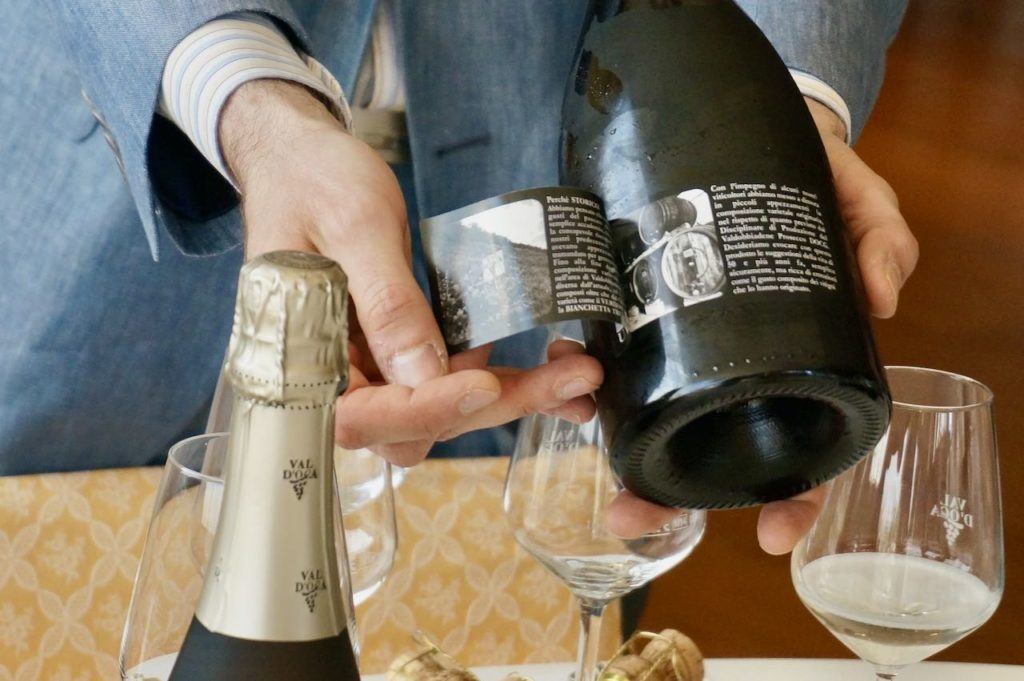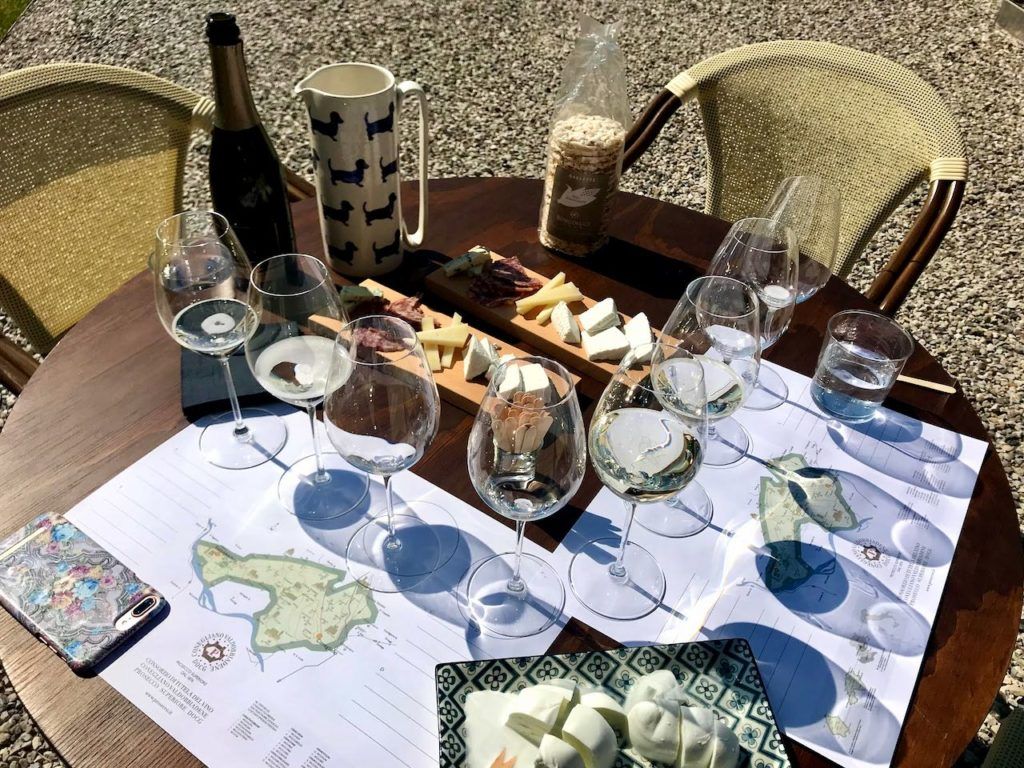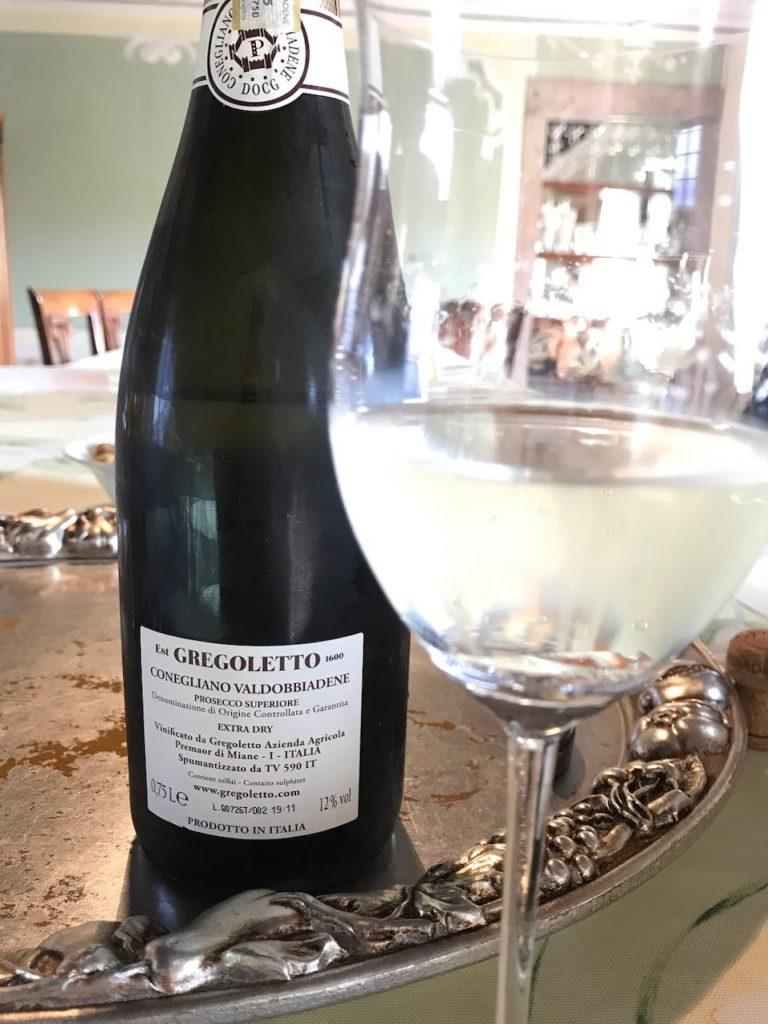Last Updated on November 3, 2023 by Jo Fitzsimons

There’s nothing like a chilled, crisp glass of Prosecco. Whether sipped on its own or using its aromatic fizz to elevate flavours in a cocktail, a glass of fruity, sparkling wine can lift the spirits and transport you to the verdant hills of northern Italy.
But how can you tell if you’re drinking good Prosecco? When toasting a special occasion, Prosecco can be charmingly inexpensive compared to Champagne; but have you selected the very best and is it authentic rather than imitation?
Spending some time learning a little bit about the bubbly stuff and its origins could make the difference between an average fizz and a superior one. Here’s our guide to choosing the best Prosecco out there.
1. Check the Prosecco is Italian
Chemist Antonio Carpané, produced the first bottle of sparkling Prosecco in 1868. He was convinced that a wine as good as Champagne could be produced in Italy – and he was right.
It’s important to understand the geography behind Italy’s Prosecco production, though. Prosecco doesn’t have the same ‘local’ protection that Champagne does (to call it Champagne, it must come from the Champagne region of France). That means there are many producers out there, including from countries such as Australia, producing Prosecco.
So, if you want authentic, Italian Prosecco (trust us: you do want Italian Prosecco), check the label to make sure it’s produced in Italy. The specific words you’re looking for are: ‘Prodotto in Italia’. Translation: produced in Italy.
2. Make sure it’s at least 85% Glera grape

Wine can be confusing. Sometimes the wine is named after the wine region (example: Champagne). Sometimes it’s named after the grape (example: Chardonnay). And sometimes it’s named after the tiny town where it originated from even though the main production area has shifted (our friend, Prosecco).
So, what’s Prosecco made from? The answer: Prosecco is from the Glera grape. This green-skinned grape ripens late in the season and is a semi-aromatic variety; meaning it can be quite fragrant, floral and fruity.
Chances are you’ve not heard of the Glera grape before but that doesn’t matter. The important point to note is that a bottle of Prosecco must contain a minimum of 85% Glera grape for it to be considered Prosecco. If it’s not got the right amount of Glera, you’re just getting sparkling Italian wine.
The extra confusing part: the best Prosecco (DOC and DOCG – see below) is so good, it doesn’t need to tell you that the Glera grape is in there. Consequently, if you’re seeing the words Glera on the bottle and no DOC or DOCG, you’re actually getting an inferior Prosecco bottle.
3. Choose DOCG or DOC

If you’re in a rush, make searching for ‘DOCG’ on the label the one thing you do before dashing to the till. DOC and DOCG are quality classifications that confirm the product you’re about to swap for your hard-earned cash is made to certain quality standards.
DOC (translated in English as Controlled Destination of Origin) is a fair place to start if you’re looking to buy good Prosecco as it will give you the assurance that it is, at least, produced in the main, high-quality production region of Veneto and Friuli Venezia Giulia in north-east Italy. Most of the Prosecco found in European supermarkets is DOC.
However, if you’re looking for really good Prosecco, look for one that has DOCG on the label. DOCG (Denomination of Controlled and Guaranteed Origin) can only be used when the wine is made from the limestone-rich area located between the towns of Conegliano and Valdobbiadene. This region is the epicentre of Prosecco Superior – the best Prosecco there is. This is mainly due to:
- the quality of the soil (with a rich sediment from the mountainous glaciers with fruity and flowery notes)
- the steepness of the hills which is hit by the sunlight in just the right way and also allows the rain water to travel down the valley instead of making the soil rotten
- the shape of the hills which creates the perfect ventilation
- the manual harvest that filters out the rotten berries and allows the grape to remain untouched until it is pressed
Here’s the classification system for Italian wine:
ITG (Indicazione Geografica Tipica) – this is reserved for wines that may not meet all of the standards of a DOC or DOCG wine but are nevertheless considered to be very good quality.
DOC (Denominazione di Origine Controllata) – these wines have to meet strict standards to earn their DOC label. Most of the Prosecco from the Veneto and Friuli regions of Italy are DOC and are definitely good Prosecco.
DOCG (Denominazione di Origine Controllata e Garantita) – the standards are higher for DOCG wines and therefore the quality is much better. DOCG Prosecco comes from a much smaller region within Veneto-Fruili known between the towns of Conegliano and Valdobbiadene and is known locally as Prosecco Superiore DOCG.
Typically, you can find at least one DOCG Prosecco on the supermarket shelves and it’s not usually that much more than the price of your DOC. But if you want really good Prosecco…
4. Buy from a specialist wine shop
Why not swerve the supermarket and check out your nearest independent wine shop?
Many of them have trained, qualified staff who are happy to natter about Prosecco in all its effervescent glory. Some offer courses and tastings that could help you discover something new, and deliver if you’re pressed for time.
Pro-tip for choosing good Prosecco: if you can get your hands on any Prosecco from the Cartizze region, you’ve hit the jackpot. Considered to be the Rolls Royce of Prosecco, Cartizze is a tiny area located with the DOCG Prosecco (superior) region and it tastes like liquid gold. Historically, Cartizze was produced as a dry Prosecco (which means the sweetest wine, see below) as the grapes grown on the Cartizze hill get the best of the sun. More and more brut Cartizze is being produced which some experts think is messing with history too much. My suggestion: try a dry (sweet) and try a brut (dry), then drink what you like.
Typically, you need to be in Cartizze to taste Cartizze but you might find a stray bottle ignored by the untrained eye in a wine shop. May the odds be ever in your favour. Otherwise, you can take a tour of the Prosecco region where you can add Cartizze to your itinerary.
5. Go Prosecco tasting in a local Prosecco Bar
Doing a recce in a bar that stocks a good range of sparkly is the kind of research we like. If nothing on the menu catches your eye, ask the bar staff to talk you through their favourites. Scribble some notes on your favourite tipple; its appearance (such as colour or perlage, a fancy way to describe the quality and character of the fizziness), the aroma, whether the flavour lingered or disappeared and most importantly, how it tasted.
Prosecco House near London’s Tower Bridge has 28 types of premium Prosecco on the menu and often has tasting events.
6. Don’t drink Prosecco on-tap
Prosecco on tap might sound like the world’s best invention, but in reality it won’t deliver high-quality fizz because it’s not actually Prosecco. If your Prosecco comes from a tap, or a keg, be suspicious. It’s likely to be just sparkling wine, as (for quality reasons) Prosecco needs to be served directly from the bottle.
If you’re in a bar and after a refreshing aperitif or cocktail but want the real deal, inspect the menu closely and don’t be afraid to ask what the bubbles actually are.
7. Understand Italian wine sweetness (it’s confusing)

Matching your Prosecco to your personal tastes is an important part of finding a good Prosecco. Unfortunately, the clue is NOT in the name – the labels can add to the confusion to the buying process. Here’s our cheat’s guide to reading a Prosecco label:
Extra Brut – At between 0-6 grams of residual sugar, try this if you’re after a very dry Prosecco.
Brut – This contains between 6-12 grams of residual sugar and offers a dry, robust, flavour that is a touch sweeter than extra brut.
Extra Dry – At 12-17 grams of residual sugar, this can be a nice, in-betweener which is often found with apple and citrus notes. However, if you’re used to drier styles of wine, you might find this too sweet.
Dry – This is the where you’re most likely to get confused because ‘Dry’ Prosecco, with between 17-32 grams of residual sugar, is the sweetest of them all. Perfect if you like your Prosecco on the sweet-side but a big mistake if you’re hoping for a drink that is actually dry.
What might surprise you is how good dry Prosecco is for pairing with food – nope, it’s not just an aperitif drink. Dry Prosecco pairs well with sweet food but also fatty fish like salmon, fried fish (yep, you Brits have just been given permission to drink dry Prosecco with your fish and chips) and crustaceans such as shrimps and mussels.
One to look out for: There is a new breed of Prosecco called Prosecco Zero that has 0 grams of residual sugar (also known as zero dosage and brut nature). Definitely give it a try but two words of caution: first, it is super, super, super dry. Possibly too dry for most people. Also, at zero grams of residual sugar, many producers are touting this as ‘skinny’ or ‘diet’ Prosecco. For the sake of saving a handful of calories per glass, we’d recommend going for quality over calories. If you don’t like the taste, go back to what you enjoy.
Related: Italian Aperitivo – Everything You Need To Know | Ultimate Prosecco Food and Wine Pairing Guide | How to Drink A Passion Fruit Martini | 12 Easy Prosecco Cocktails To Make At Home
8. Choose from our list of favourite Prosecco brands
Pushed for time, but looking to impress (and pretend you’re part-oenologist)? Check out our guide to the best Prosecco Vineyards. Sure, you might be ‘visiting’ from the shelves of your local wine shop rather than Italy, but it gives you a good place to start.
Simple!
9. Go Prosecco tasting in Italy’s Prosecco Region

We’d be remiss if we didn’t recommend that you elevate your Very Important Prosecco Research to another level, and enjoy a wonderful Italian break at the same time.
You simply can’t beat tasting the best Prosecco in the very region of Italy where it is grown. Just one-hour away from Venice, you can discover the region, learn about the Prosecco production process and get a real insider’s knowledge on how to choose a good Prosecco. You’ll come home happier, rested and more knowledgable on all things fizz. Win-win. You can find out more about Visit Prosecco Italy’s tours of the Prosecco region here.
Finally, if you’ve tracked down your favourite Prosecco in Italy, why not consider having it shipped to you? You can do this through one of the Visit Prosecco Italy tours – the drivers can connect you with a shipping company that can send wine home for you at a decent price. Otherwise, here’s our guide to packing wine in your suitcase.
10. Visit a Prosecco Festival
Finally, why not celebrate your love of the fizz by heading out to a Prosecco festival? The UK’s Prosecco Festival, held across national locations including Bristol and Liverpool, offers over 40 types of Prosecco and sparkling wine. It’s a great way to discover, and sample, a great selection of Prosecco all at once as well as well as enjoy delicious Italian street food and live entertainment.
You knew you loved Prosecco, but maybe not the breadth of quality and styles of your favourite Italian sparkly. Now, you know your DOCG from your DOC and how to look for a persistent perlage.
You can spot whether the bubbly is sweet or dry without even tasting it and know to shop local for that extra special bottle. Enjoy – and get your good Prosecco party started.

Prosecco Tasting Notes
These tasting notes have been written to help you choose Prosecco if you’re ordering from a specialist wine shop. Some of this Prosecco you therefore won’t be able to find easily outside Italy or specialist wine shops. But some of them, like Brut and extra dry and frizzante are more widely available.
Cartizze is considered to be the Rolls Royce of Prosecco with grapes harvested from the sunniest, steepest slopes.
Brut is one of the most well-known and well-loved Prosecco. Perfectly dry (and perfect with pizza). Try it from 3 of our favourite DOCG Superiore vineyards.
Extra Brut is like Brut but even drier with almost no residual sugar remaining. Try it. It could be your new favourite Brut.
Extra dry is a little sweeter than Brut (though not like the sugary sweet sparkling wines you’ve probably tasted before). It’s elegant, subtle and makes a great aperitif or party starter.
Frizzante – Prosecco grapes with a shade less sparkle.
Tranquilo – did you know there you can get still white wine from the Prosecco region? This white wine is a conversation starter.
Col Fondo – heritage Prosecco made the old way with the yeast in the bottle. Pair with cured meats and Italian cheese.
So, that’s our guide to how to choose good Prosecco. Got any questions or recommendations? Let me know in the comments below.
Related Articles:
- 25 Prosecco Gifts (You’ll Want To Keep For Yourself)
- 10 Top Italian Wines You Need To Know
- What is Prosecco & Everything You Want To Know
- 12 Prosecco Cocktails To Make At Home
- Classic Aperol Spritz Recipe (& Some Variations)
- There’s a Prosecco Vending Machine in Italy & Here’s How To Visit
- 14 Types of Italian Cheese Everyone Needs To Know
- 11 Best Italian Pastries (With Recipes)
- 14 Famous Italian Drinks To Try In Italy (Or At Home)
- 7 Simple Steps To Host a Wine Tasting at Home
Like this guide? Share it on Pinterest…

This post was written by the wonderful Nicola Greenbrook, a London-based freelance writer who helps her clients find a way with words. You can find out more about her work here.

Grazie Mille…..I will take your advice to heart ….spend winters in Mérida Mexico and have wonderful wine stores there. Look forward to visiting the regions of Prosecco DOCG.
I have visited Merida in Mexico, happy memories. I hope you enjoy your visit to Prosecco when you get there 🙂
Hi,
Prosecco does have a protection since 2008. Since then austria is banned from producing prosecco. The original grape was named prosecco, then it was renamed to glera.
But for now that protection only applies for sales within the EU, not places like Australia and Brazil which also produce Prosecco.
Hi, I live in the area. Many compliments to you for the clear and complete explanation about prosecco AND cartizze. A cousin in California asked me about prosecco and I’ve sent this along to him with my modest comments.
Hi Susa, thanks for the compliment – from a local it’s a huge honour. Thanks for sharing 🙂